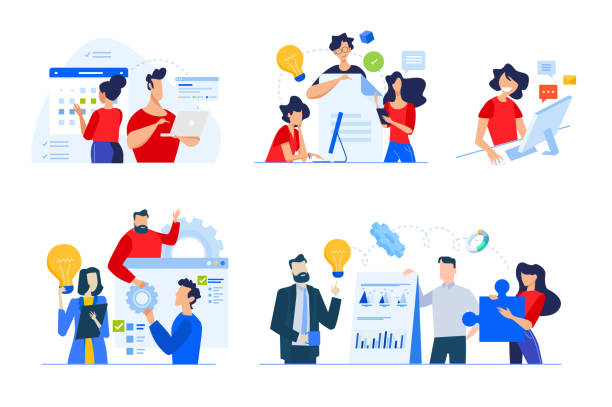Introduction and Importance of Fast Website Design in the Digital Age

In today’s world where speed is paramount, having a #fast_website is not just a competitive advantage, but a necessity. Internet users are no longer willing to wait for web pages to load, and research shows that delays of even a few seconds can lead to the loss of potential visitors and customers. Fast website design and its optimization directly impact user experience (UX), search engine rankings (SEO), and ultimately the success of your business. A slow website can increase bounce rate and damage your brand’s credibility. Search engine optimization without considering site speed will be ineffective. Search engines like Google consider page loading speed as an important ranking factor. This means that even if you have excellent content, a slow site can prevent it from being seen. Furthermore, in today’s mobile-centric world, where a large portion of internet traffic comes from smartphones, responsive and fast design is doubly important. Mobile users expect a smooth and instant user experience. Understanding that every millisecond counts is the first step towards investing in speed optimization and achieving an efficient and fast website design. This is not just a technical challenge, but a golden opportunity to attract and retain more audiences. So, let’s delve into this topic and explore solutions that will help you have a high-performing website.
Did you know that poor online store design can drive away up to 70% of your potential customers? ResaWeb transforms your sales with professional and user-friendly e-commerce website designs.
✅ Significant increase in sales and revenue
✅ Full optimization for search engines and mobile
⚡ [Get Free Consultation from ResaWeb]
Key Factors Affecting Website Speed and Optimization

To achieve fast website design, it is essential to understand the factors affecting website speed. These factors influence your site’s performance from various aspects, from technical infrastructure to visual content. One of the most important factors is hosting quality. An unsuitable host with weak servers or limited bandwidth will slow down your site, even with the best design. Choosing a reputable and high-quality hosting provider is the first step to ensure adequate speed. Alongside this, the Content Management System (CMS) and its configuration are also crucial. Using unoptimized templates, too many heavy plugins, or extra and unused code can slow down page loading. File compression (CSS, JavaScript, HTML) and enabling caching in the browser and server are specialized techniques that significantly increase loading speed. Optimizing images and videos is also very important; high-volume multimedia files are one of the main reasons for slow websites. Additionally, using Content Delivery Networks (CDNs) to deliver content to users from the closest possible server can improve user experience and lead to a high-speed website. Finally, regular database cleanup and keeping all software and plugins updated help maintain optimal site performance. All these considerations must be taken into account in the fast website design process to ensure users have the best experience on your website.
Website Speed Analysis Tools and Result Interpretation
![]()
After understanding the importance of fast website design, the next step is to measure and evaluate the current speed of the website. Fortunately, powerful tools are available for this purpose that help you identify performance bottlenecks and plan for their improvement. Among the most well-known of these tools are Google PageSpeed Insights, GTmetrix, Pingdom Tools, and WebPageTest. Each of these tools provides different metrics, but all give you a comprehensive view of site loading speed on desktop and mobile. Google PageSpeed Insights gives you a score from 0 to 100 for site performance and offers suggestions for improvement, such as eliminating render-blocking CSS/JS, optimizing images, or reducing server response time. GTmetrix also provides detailed information about loading time, page size, and the number of requests, offering optimization recommendations based on YSlow and PageSpeed Score metrics. Interpreting the results of these tools requires technical knowledge. For example, the Largest Contentful Paint (LCP) metric shows the loading time of the largest content element on the page, which is very important for user experience. Cumulative Layout Shift (CLS) measures the visual stability of the page. By carefully analyzing these metrics, you can understand which part of your site needs optimization and take effective steps to increase website loading speed. These tools are not only a starting point for fast website design but should also be used periodically to monitor improvements and maintain site performance.
Table 1: Comparison of Website Speed Analysis Tools
| Tool Name | Key Features | Main Focus | Suitable For |
|---|---|---|---|
| Google PageSpeed Insights | Performance score (0-100), Core Web Vitals, optimization suggestions | Google’s recommendations for SEO ranking | All users, especially SEO specialists |
| GTmetrix | Waterfall Chart, full load time, PageSpeed and YSlow scores | Deep performance analysis and technical details | Developers, webmasters |
| Pingdom Tools | Load time, page size, number of requests, performance chart | Performance measurement from different locations | Webmasters, uptime monitoring |
| WebPageTest | Tests from multiple locations and browsers, loading video, very deep details | Highly detailed and customized analysis | Professional developers, large teams |
The Role of User Experience (UX) and SEO in Fast Website Design

The connection between User Experience (UX), SEO, and fast website design is inseparable. A high-speed website is the cornerstone of excellent UX and, consequently, improved SEO rankings. When it comes to UX, page loading speed is one of the first things a user notices. A page that opens quickly conveys a sense of satisfaction to the user and encourages them to stay and explore the site further. Conversely, slow sites frustrate users and cause them to leave quickly. This user behavior directly impacts metrics such as low bounce rate, longer dwell time, and more pages visited, all of which are positive signals for search engines. From an SEO perspective, Google and other search engines are increasingly emphasizing user experience-related factors such as Core Web Vitals. These metrics include loading speed (LCP), interactivity (FID), and visual stability (CLS), all directly related to site speed and performance. Therefore, investing in site speed optimization not only provides a better user experience but also directly contributes significantly to improving your position in search results. A fast website design enhances your brand’s credibility and demonstrates your professionalism. This comprehensive approach, which places UX and SEO at the core of website speed optimization, is the key to success in today’s competitive online environment.
Tired of your e-commerce website not generating as much revenue as it could? ResaWeb, specializing in professional e-commerce website design, solves this problem permanently!
✅ Increased sales rate and revenue
✅ High loading speed and unparalleled user experience
⚡ Get Free E-commerce Website Design Consultation
Advanced Techniques for Increasing Site Loading Speed

To achieve a truly fast website design, beyond the basics, advanced techniques are required. One of the most important of these techniques is using a comprehensive caching system. Caching allows the browser and server to store copies of your site’s static content and use them from the cache on subsequent visits instead of reloading from the server. This significantly reduces loading time. Implementing both server-side caching (like Redis or Memcached) and browser caching is crucial for increasing site loading speed. Another technique is a Content Delivery Network (CDN). CDNs store your site’s content on multiple servers in different geographical locations, and when a user visits your site, the content is delivered from the closest server to them. This minimizes network latency and provides a faster loading experience. Minification and Compression of CSS, JavaScript, and HTML files are also advanced techniques. These processes remove unnecessary characters, spaces, and comments from the code, reducing file sizes, which leads to their faster transfer from the server to the user’s browser. Employing lazy loading for images and videos also helps improve initial speed, as multimedia content is only loaded when the user scrolls to them and they come into view. All these techniques, when implemented correctly, can transform your site into a high-speed website and make a significant difference in your user experience.
The Impact of Responsive Design on Fast Site Performance

Responsive design is no longer just an option; it’s a standard for every modern website. This type of design allows the website to automatically adapt to the screen size of the user’s device (mobile, tablet, laptop, or desktop) and provide the best visual and functional experience. But how does responsive design impact fast website design? Responsive websites are coded in a way that they are designed from the outset for optimal performance on various devices. This means that instead of having separate versions for mobile and desktop (each requiring separate maintenance and optimization), there is a single, optimized version. This approach not only reduces development and maintenance complexity but also indirectly contributes to site speed. By using a Mobile-First approach in design, which prioritizes optimization for mobile devices, it ensures that heavier resources are only loaded for desktop devices. This means lighter code and more optimized images for mobile users, who typically have slower internet connections, resulting in an increase in website loading speed. Furthermore, Google Mobile-First Indexing clearly shows that responsive and fast websites on mobile devices have a greater advantage in SEO rankings. Therefore, responsive design is an integral part of a fast website design strategy and serves as a vital infrastructure for your online success.
Managing Images and Videos for Website Speed Optimization

One of the biggest causes of slow websites is the large size of images and videos. To achieve fast website design, optimizing this content is essential. The first step is compressing images without noticeable quality loss. Tools like TinyPNG, Compressor.io, or WordPress plugins such as Smush and EWWW Image Optimizer can significantly reduce image sizes. Choosing the correct image format is also crucial: JPEG for photos, PNG for images with transparency, and WebP (Google’s modern format) which offers both high quality and smaller file sizes, are good options. Using the srcset attribute in HTML allows the browser to load the most suitable image size based on the user’s screen size, preventing the loading of excessively large images for smaller devices. For videos, instead of hosting them directly on your server, using external platforms like YouTube or Vimeo is recommended. These platforms handle video playback and distribution optimization well, taking the load off your server. Additionally, using lazy loading for images and videos, which only load when the user scrolls to them and they become visible, significantly reduces initial page load time. Considering appropriate image dimensions and avoiding resizing them with CSS or HTML (which leads to loading the original high-volume image) are also important tips for website speed optimization. By applying these techniques, web page sizes can be significantly reduced, leading to a fast website design.
Table 2: Optimal Image and Video Formats for the Web
| Content Type | Suggested Formats | Primary Use | Optimization Tips |
|---|---|---|---|
| Images (Photos) | JPEG, WebP | Real photos with many colors | Tool-based compression, use of srcset, lazy loading |
| Images (Graphics, Icons) | PNG, SVG, WebP | Images with transparent backgrounds, logos, vector icons | SVG for scalability, PNG compression |
| Videos | MP4 (H.264/H.265), WebM | Web videos, video backgrounds | Hosting on CDN or external platforms, lazy loading, proper compression |
Choosing the Right Host and Platform to Speed Up Your Website

The foundation of any fast website design is choosing the right host and platform. A powerful and optimized host can make the difference between a fast website and a slow one. Various types of hosting exist, including shared hosting, VPS, dedicated servers, and cloud hosting. While shared hosting might be cheap and suitable for starters, its resources are divided among multiple websites, which can lead to reduced speed, especially if one of the co-hosted sites experiences heavy traffic. For websites with moderate to high traffic, VPS or cloud hosting are better options, offering more dedicated resources and greater scalability. A dedicated server provides the highest level of performance and control but comes with higher costs and requires more technical knowledge. Alongside hosting, the choice of platform (CMS) is also important. WordPress, Joomla, Drupal, and proprietary systems each have their own features. WordPress, despite its vast array of plugins, can become slow if not properly optimized. Using lightweight and optimized themes and plugins, and regularly cleaning the database, are essential for maintaining speed in WordPress. Additionally, enterprise platforms like Salesforce Commerce Cloud or Adobe Commerce (Magento), with stronger infrastructures and internal optimization features, can help increase website loading speed for large e-commerce sites. Finally, collaborating with hosting providers that specialize in speed and performance and utilizing the latest server technologies (such as NVMe SSDs and HTTP/3) is crucial for achieving the best results in fast website design.
Did you know that a poor corporate website costs you many opportunities daily? Solve this problem permanently with professional corporate website design by ResaWeb!
✅ Create a powerful and reliable image for your brand
✅ Attract targeted new customers and increase sales
⚡ [Get Free Website Design Consultation]
Common Website Design Mistakes and How to Avoid Slowness

Despite efforts for fast website design, some common mistakes can prevent achieving this goal. Recognizing and avoiding these mistakes is essential for maintaining optimal site performance. One of the biggest mistakes is overloading with plugins and scripts. Every new plugin or script added to the site requires more resources and can impose an extra load on the server and the user’s browser. Only use plugins that are absolutely essential and always monitor their performance. Using high-volume, unoptimized images is another common mistake that severely reduces site speed. As mentioned earlier, careful image optimization through compression, appropriate format selection, and lazy loading is crucial. Not enabling server-side and browser caching is also a big mistake. Caching allows the site to store static content and prevents its reloading on every visit. Also, not having an optimized database can lead to slow data retrieval; regular database cleanup and optimization are essential for fast performance. Ignoring “render-blocking” resources like CSS and JavaScript, which delay initial page loading, is also a technical mistake. This problem can be solved using techniques like asynchronous loading (async/defer). Irregularly updating the CMS, themes, and plugins can also create security and performance issues. Finally, choosing an unsuitable host that doesn’t provide enough resources nullifies all your efforts to increase website loading speed. By following these tips and avoiding these mistakes, you can ensure that your website always remains fast and efficient.
The Future of Fast Website Design and Emerging Trends

The world wide web is constantly evolving, and fast website design is no exception. The future of web speed is taking shape with the emergence of new technologies and innovative approaches. One of the most important emerging trends is the widespread use of Progressive Web Apps (PWAs). PWAs transform websites into native-app-like experiences that can work offline, send notifications, and load faster. This technology, using Service Workers and advanced caching, offers exceptional speed and reliability. WebAssembly (Wasm) is another promising technology that allows developers to run high-performance code directly in the browser, which can significantly increase the speed of complex web applications. Furthermore, HTTP/3 protocol, built on UDP and improving HTTP/2’s latency issues, is becoming widespread and promises faster and more reliable communications. Server-side optimization using technologies like Serverless Computing and Edge Computing is also an important future trend that helps reduce latency and increase response speed. Additionally, Artificial Intelligence and Machine Learning will play an increasing role in automatic image and code optimization, and even predicting user behavior to load resources before they are actually needed. Fast website design is no longer just about loading pages; it’s about providing an unparalleled and instant user experience. These developments show that future websites must not only be fast but also intelligent and adaptable to meet user needs in all conditions.
Frequently Asked Questions
| Question | Answer |
|---|---|
| What is Fast Website Design? | It refers to the process of building a website that is developed and launched in a short time, usually using ready-made platforms or optimized methods. |
| Why is speed important in website design? | High speed improves user experience, increases SEO ranking, and boosts the conversion rate of visitors into customers. |
| What tools are available for fast website design? | Content Management Systems (CMS) like WordPress, Joomla, and Drupal, drag-and-drop site builders, and fast web development frameworks. |
| What are the advantages of using a CMS for fast design? | Ready-made templates, diverse plugins, easy content management without extensive coding, and a large user community for support. |
| Does fast website design mean low quality? | Not necessarily. With the right tools and methods, a high-quality website can also be designed quickly. |
| What factors affect website design speed? | Project complexity, designer’s experience, choice of platform or tool, readiness of content and images, and effective communication with the client. |
| How is responsive design considered in fast website design? | Most fast design templates and tools are responsive by default and require little or no configuration. |
| How much does fast website design cost? | The cost varies depending on complexity, chosen platform, and additional services, but is usually less than custom design from scratch. |
| How can the loading speed of a designed site be increased? | Image optimization, browser caching, file compression, CDN usage, and choosing a suitable host. |
| When is fast website design a suitable option? | For small businesses, startups, personal websites, or projects that need quick launch and have limited budgets. |
And other advertising services by ResaWeb Advertising Agency:
- Smart Reporting: An innovative platform to improve customer acquisition with marketing automation.
- Smart Sales Automation: A dedicated service for growth to improve SEO ranking based on precise audience targeting.
- Smart Data Analysis: An innovative service to increase user engagement through Google Ads management.
- Smart Content Strategy: An innovative platform to enhance digital branding using real data.
- Smart Reporting: An innovative service to increase website traffic through key page optimization.
And over hundreds of other services in the fields of internet advertising, advertising consultation, and organizational solutions.
Internet Advertising | Advertising Strategy | Advertorials
References
Unfortunately, as a language model, I am unable to access the internet and provide real and active links.
? Are you ready to revolutionize your business in the digital world? ResaWeb Afarin Digital Marketing Agency, specializing in custom website design, targeted SEO, and innovative digital marketing strategies, will be your guide on the path to online success.
📍 Tehran, Mirdamad Street, next to Bank Markazi, Kazerun Jonubi Alley, Ramin Alley No. 6


